Pelagic Life: Nurturing the soul in the open ocean
“So are we really going to swim with sharks?” I asked my fellow divers. We were in the ocean waters near Baja California on an expedition with Pelagic Life, a Mexican non-profit organization dedicated to raising awareness of pelagic species (pelagiclife.com). The word “pelagic” comes from the Greek π×ελαγος or pélagos, which means “open sea.”
Inspired by my love of aquatic nature, a year ago I became involved with Pelagic Life, which was founded by underwater filmmaker and photographer Jero Prieto. With a team of dedicated contributors passionate about underwater living organisms, Pelagic Life organizes expeditions to the Pacific Ocean, Gulf of California and Gulf of Mexico to document marine life. “The idea is to nurture our soul in the open ocean,” Prieto says.

The following are more spectacular photographs taken over the past two years by the Pelagic Life team.
Zapata, a white shark trying to reach its bait, Guadalupe Island
With clear skies and a stunning 30-35 metres of visibility, eight divers in surface cages and two in submersible cages discovered seven great white sharks—a photographer’s dream come true. Our best performer was Zapata, a five-metre male shark with a dominant personality and deadly scars.

Saving a blue shark hooked to a buoy, Baja California
We came upon a blue shark fighting to free itself from a fish hook. We offered to pay the fishermen to let us set it free, and they agreed. Putting our bare hands near the shark’s mouth was not only difficult but dangerous. One of us immobilized the shark by holding its snout, a technique known as tonic immobility. It worked like a charm and after a few attempts, the shark was swimming free and healthy.
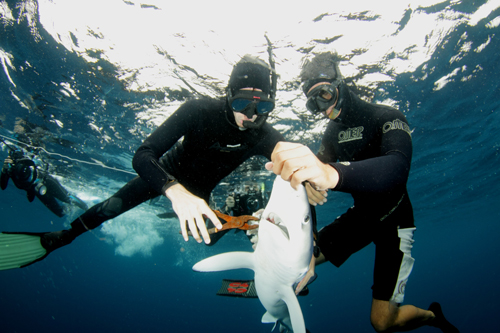
We quickly paid the fishermen to liberate any sharks they found alive in their traps. We were ecstatic with this opportunity to make a tangible difference while still respecting the livelihood of the fishermen, who have families to feed.
Sailfish fishing sardines, Isla Mujeres
It was early morning; with the boat was moving and wind blowing, we were searching for sailfish—and proudly singing the Mexican national anthem at the top of our lungs.
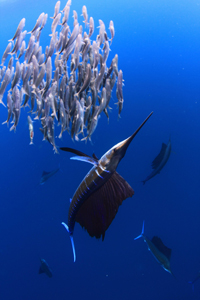
We finally spotted a group of birds swarming right above the surface: jackpot! It was an army of 40-plus sailfish charging towards a bait ball (a tightly packed fish swarm) of sardines.
The sailfish soon penetrated the ball to catch individual fish. When attacked, the sardines dispersed but quickly reunited.
The sailfish took turns, brightened their colours—green, yellow, orange—as a warning, brought up their silky sails to keep the bait ball in place, and used their bills to snatch a sardine to munch.
They didn’t stop until they ate through the whole bait ball.
The ocean water glimmered with the scales of the defeated sardines.
Monica Lafon learns that rusty loggerhead turtles can snap, Baja California
We noticed a rusty-coloured turtle followed by reef fish, which eat algae off the turtle’s shell. The turtle approached us in what we thought was a friendly manner, so we caressed its shell. But then it suddenly started to snap at the camera! We had to swim faster than her, which wasn’t easy. Fortunately, I was able to dive deeper and watch the turtle swim above, near the surface.
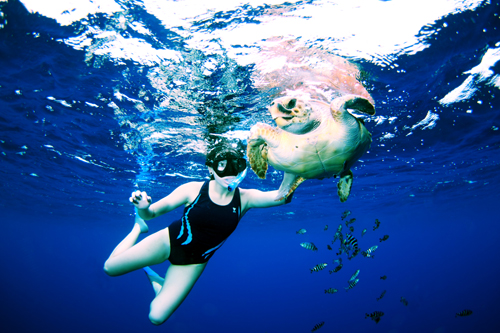
School of spinning dolphins bubbling away, Acapulco
This was one of the largest schools of dolphins we had ever seen, with a few huge yellow-fin tunas joining their hunt. After slowly following to make sure they became comfortable with our boats, we jumped in the fin, showed our bellies, made weird noises and nodded. Amazingly—and unforgettably—the dolphins soon began interacting with us.
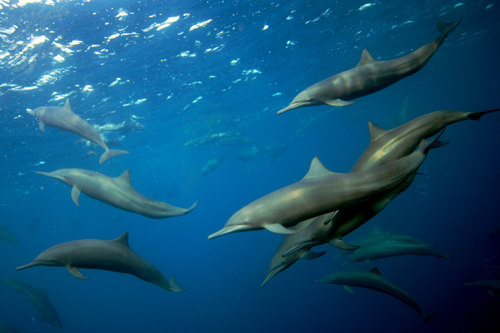
Silky shark posing for a picture, Acapulco
Near the coast of Acapulco, we unexpectedly encountered a great deal of species. Acapulco’s waters are thought to be devoid of life—which is clearly untrue.
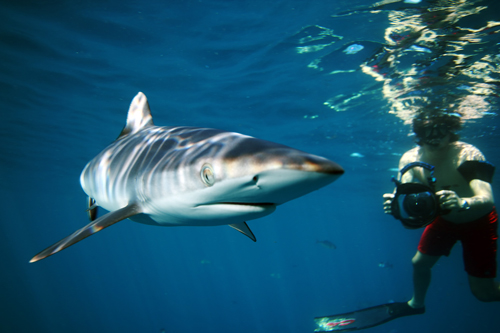
This silky shark was surprised to find us swimming along with him, but he didn’t seem bothered by the photographer; rather, he seemed to know that every time the flash went off, he could try a different pose. Our encounter should remind us that ocean species are curious about us as well.
Bronze whaler sharks fishing bait ball, Baja California
These incredible shots of a bait ball being devoured by bronze whaler sharks were a great accomplishment for our team of videographers and photographers because it was the first time this phenomenon had been documented in Mexican waters. But it took some courage and patience to witness this natural slaughter.
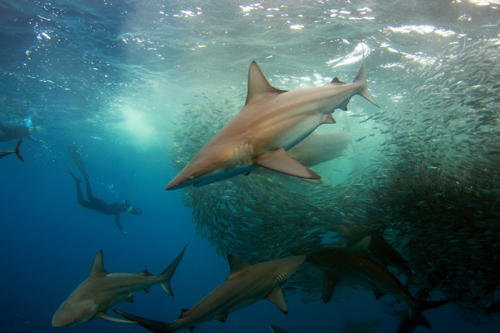
Related link:
• Pelagic Life